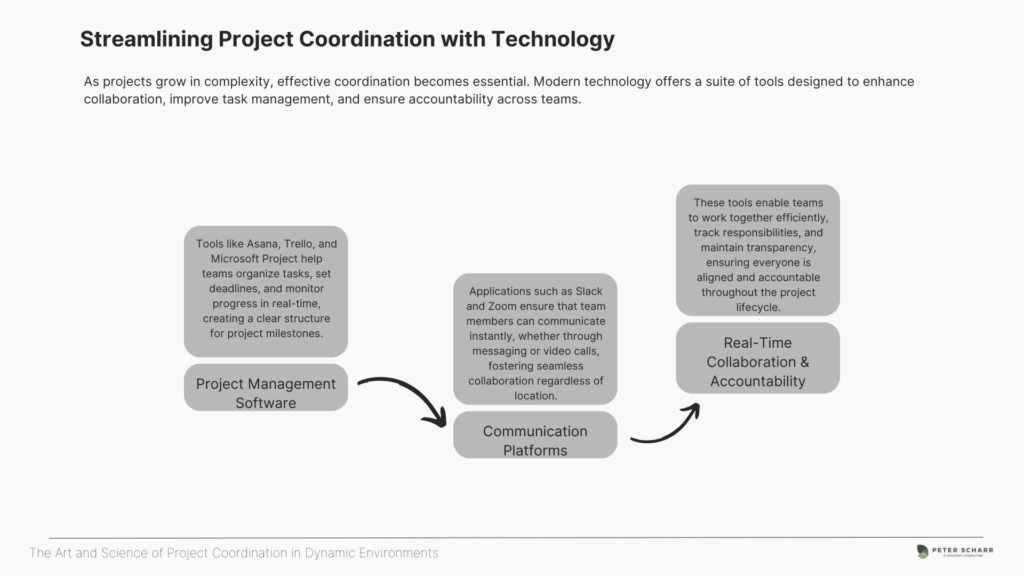Defining Project Coordination – Foundations and Core Principles
At its core, project coordination is all about bringing people, tasks, and resources together in a way that makes everything run smoothly. But what exactly does that mean, and why is it so crucial in today’s fast-paced work environments? Let’s break it down.
What Does a Project Coordinator Do?
The role of a project coordinator often flies under the radar, but it’s one of the most essential positions on any project team. The project coordinator is the glue that holds everything together, making sure that deadlines are met, resources are efficiently allocated, and everyone is on the same page. They don’t just manage individual tasks—they make sure that all the moving parts are synchronized.
Think of a project as a complex puzzle with many pieces. A project coordinator ensures that each piece fits together properly, so the overall picture comes together without delays or confusion. They communicate with team members, keep track of progress, and handle unexpected changes with grace. In short, without effective coordination, even the best-laid plans can quickly go off the rails.
Why Collaboration is Key
Project coordination is not a one-person show. It’s deeply rooted in collaboration—both within teams and across departments. A successful project coordinator knows how to foster collaboration, ensuring that everyone feels heard and that their contributions are valued. This creates a more productive and positive environment where teams can thrive.
In dynamic environments, where things can change quickly, having a team that communicates well and works together effectively is critical. The project coordinator is often the one who builds those bridges, making sure that information flows smoothly and that teams can adapt to changes without losing momentum.
Core Skills for Effective Project Coordination
Managing competing priorities, stakeholders, and resources is no small task. A great project coordinator needs a wide range of skills to juggle everything successfully. Here are some of the key skills that every project coordinator should have:
- Time Management: Coordinators need to keep an eye on deadlines and make sure that tasks are completed on time, even when priorities shift.
- Communication: Clear, concise communication is essential for keeping everyone in the loop and preventing misunderstandings.
- Problem-Solving: When things go wrong (and they often do), project coordinators need to think on their feet and come up with solutions quickly.
- Organizational Skills: With so many tasks to track, staying organized is crucial for ensuring that nothing slips through the cracks.
- Adaptability: Projects rarely go exactly as planned, so coordinators must be ready to adjust to new circumstances as they arise.
The Backbone of a Successful Project
Ultimately, effective project coordination is the backbone of any successful project. By managing competing priorities, fostering collaboration, and ensuring that resources are used wisely, project coordinators help guide projects from start to finish with minimal issues. As explored, their ability to keep everything aligned is especially crucial in dynamic environments, where change is constant, and flexibility is key.
Whether you’re working on a small team or coordinating across multiple departments, mastering the art of project coordination can make all the difference in achieving your goals. Understanding these foundational principles is just the start of building a more cohesive and productive project team. Stay tuned as we dive deeper into the strategies and tools that make coordination in dynamic environments more manageable.
Tools of the Trade – Leveraging Technology for Seamless Coordination
Now that we’ve established the foundational principles of project coordination, let’s shift focus to the practical tools that can make this process smoother and more efficient. In today’s fast-paced world, technology is our best friend when it comes to managing the complexities of project coordination. From streamlining communication to tracking progress in real-time, modern tools take the guesswork out of managing dynamic environments.

Project Management Software: Your Digital Command Center
Gone are the days of sticky notes and endless spreadsheets. Today, project coordinators have access to powerful project management platforms that help keep everything organized and on track. Tools like Asana, Trello, and Microsoft Project allow teams to assign tasks, set deadlines, and monitor progress—all from a centralized dashboard. This makes it easy to see which tasks are on track and which might need extra attention.
For instance, Trello’s intuitive, card-based system is perfect for visual thinkers, while Asana’s detailed task lists and timelines provide more structure for larger, multi-step projects. Microsoft Project, on the other hand, offers robust features for tracking resources and dependencies, making it ideal for more complex projects with many moving parts. Depending on the needs of your team, you can choose the tool that fits your workflow best.
These platforms also offer valuable insights through built-in reporting features. Need to know how many tasks were completed last week? Or which team members may need assistance with their workload? With just a few clicks, these tools can provide you with data that’s critical for making informed decisions.
Communication Platforms: Keeping Everyone in the Loop
As we discussed earlier, collaboration is at the heart of effective project coordination. But in dynamic work environments, it’s not always easy to keep everyone in sync. This is where communication platforms like Slack and Zoom come into play.
Slack offers real-time messaging, organized into channels for different teams or projects, so everyone stays in the loop without drowning in email chains. Need input from a specific person? You can easily tag them in a message or start a direct chat. Slack also integrates with many other tools like Google Drive and Asana, allowing you to share files or updates seamlessly across platforms.
For meetings, Zoom offers a simple, reliable video conferencing solution. Whether it’s a quick check-in or a full project review, Zoom’s video and screen-sharing capabilities make remote collaboration feel just as effective as being in the same room. With features like recording and breakout rooms, it’s easy to ensure that important discussions are captured and that smaller teams can collaborate within the larger context of a project.
Accountability Through Task Tracking
One of the biggest challenges in project coordination is ensuring that everyone stays accountable for their tasks. When working in a dynamic environment, it’s easy for things to slip through the cracks—especially when priorities shift. But with the right tools, you can ensure that tasks are clearly assigned, deadlines are visible, and progress is tracked.
Most project management platforms, like Asana and Microsoft Project, allow you to assign tasks to specific individuals and track their progress in real-time. This not only makes it clear who is responsible for what but also helps identify bottlenecks before they become bigger issues. By keeping everyone accountable, you can ensure that the project stays on track, even when adjustments are needed.
Bringing It All Together
In a world where projects often have many moving parts, the right tools can make all the difference. As we’ve seen, platforms like Asana, Trello, and Slack offer a wide range of features that simplify task tracking, communication, and accountability. By leveraging these technologies, you can create a more transparent and efficient coordination process that allows your team to focus on what they do best—getting the job done.
As you continue to develop your project coordination skills, remember that technology is there to support you, not replace the human touch. While these tools can streamline workflows and enhance communication, effective project coordination still relies on the ability to foster collaboration, solve problems, and adapt to changing circumstances—as we explored in the previous section.
Navigating Challenges – Mitigating Risks and Addressing Bottlenecks
Every project, no matter how well-planned, will face its fair share of challenges. Whether it’s resource constraints, conflicting priorities, or communication breakdowns, these risks can quickly derail progress if not addressed early. But here’s the good news: with the right strategies, you can mitigate these risks and keep your project on track. Let’s explore how.
Identifying Common Risks
As you coordinate projects in dynamic environments, it’s essential to first identify some of the most common risks that can pop up:
- Resource Constraints: Projects often have limited resources—whether it’s time, money, or personnel. Running out of any of these can cause delays or force compromises on quality.
- Conflicting Priorities: In fast-paced environments, teams often juggle multiple projects. Without proper alignment, this can lead to confusion and delays as priorities shift.
- Communication Breakdowns: As we discussed earlier, communication is key to collaboration. When communication falters, tasks get missed, deadlines slip, and teams lose trust in one another.
These challenges are common, but they don’t have to spell disaster for your project. With proactive planning, you can mitigate these risks and ensure smoother coordination.
Proactive Planning: Your Best Defense
The best way to handle risks is to anticipate them before they happen. Proactive planning means thinking ahead about potential challenges and putting measures in place to address them. For example, if you know that resources might get stretched thin, build a buffer into your timeline. If conflicting priorities are an issue, clearly define the project’s scope and make sure every team member understands it.
One effective strategy is to create a risk management plan. This document outlines potential risks, their likelihood, and how you plan to address them. Having this roadmap can help you and your team stay calm when unexpected challenges arise. Need more info? Check out this detailed guide to creating a risk management plan.
Regular Check-ins: Staying on Top of Issues
Even with the best planning, new challenges can emerge as the project unfolds. That’s why it’s important to regularly check in with your team. These check-ins don’t have to be long or complicated. A quick daily or weekly meeting—sometimes called a stand-up—can be enough to identify bottlenecks, track progress, and make adjustments as needed.
During these check-ins, ask questions like: Are there any roadblocks? Do we need additional resources? Are all team members clear on their tasks? These conversations keep potential risks on everyone’s radar, allowing you to address issues before they escalate. To learn more about running effective stand-ups, check out this helpful guide to stand-up meetings.
Transparent Communication: Keeping Everyone Aligned
As we mentioned earlier, communication is at the heart of successful project coordination. But in dynamic environments, where teams may be working remotely or across different time zones, this can be easier said than done. That’s why it’s crucial to foster a culture of transparent communication.
Encourage team members to share updates, ask questions, and raise concerns openly. Use tools like Slack or Zoom to ensure everyone stays connected, even when they’re physically apart. Transparency also means being clear about changes in priorities or timelines. If something shifts, communicate it to the team as soon as possible to avoid confusion.
Bringing It All Together
Challenges are inevitable in any project, but they don’t have to derail your efforts. By proactively planning, holding regular check-ins, and fostering transparent communication, you can mitigate risks and keep your project moving forward. Remember, it’s not about preventing every problem—it’s about being ready to adapt when they arise. With these strategies in place, you’ll be well-equipped to navigate any hurdles that come your way.


